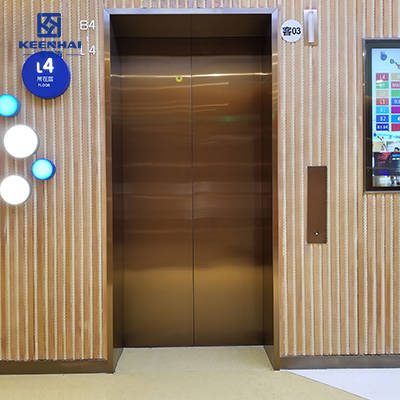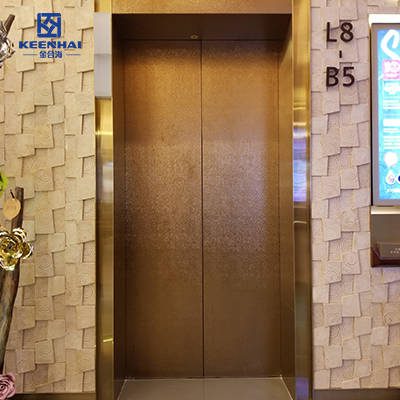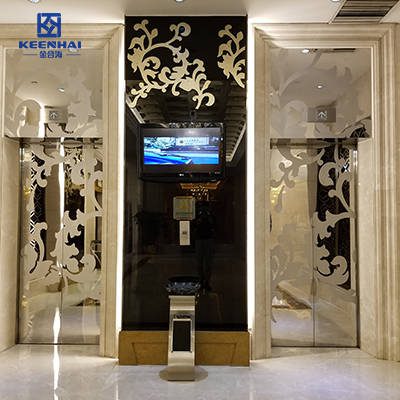Choosing the right stainless steel elevator door finish combines aesthetics, durability, and practicality. Mirror finishes create luxury and spaciousness, satin offers low-maintenance elegance, and hairline textures hide scratches in high-traffic areas. Consider lighting, interior materials, and traffic intensity when deciding. Balancing style with functional performance ensures your doors remain visually striking, resilient, and easy to maintain over time, delivering both long-term value and a polished first impression.
1. Understanding Different Stainless Steel Finishes
Choosing the right stainless steel finish isn’t just about looks—it defines how your elevator doors will perform, how easily they’ll age, and how people perceive your building from the very first glance. Each finish tells a story of texture, reflection, and durability. When selecting a custom stainless steel elevator door design, you can explore multiple surface treatments that balance elegance and long-term performance — such as mirror, hairline, satin, or etched finishes.
1.1 Common Finish Types: Mirror, Hairline, Satin, and Etched
Different finishes create different personalities for an elevator entrance.
A mirror finish delivers a high-reflective surface often used in luxury hotels, corporate lobbies, or retail showrooms, where lighting plays a key role in space perception.
A hairline finish, on the other hand, provides a fine linear texture—modern and subtle—ideal for high-traffic commercial buildings that demand a clean yet scratch-resistant appearance.
The satin finish softens reflections, blending functionality with warmth, while etched finishes allow for creative designs such as patterns or custom branding.
Here’s a quick comparison of how these finishes differ in function and visual impact:
| Finish Type | Visual Effect | Scratch Resistance | Maintenance Level | Ideal Application |
|---|---|---|---|---|
| Mirror | Highly reflective, bright | Low | Yüksək | Hotels, malls, luxury offices |
| Hairline | Subtle linear texture | Yüksək | Low | Commercial elevators, offices |
| Satin | Soft sheen, matte tone | Orta | Orta | Residential or boutique interiors |
| Etched | Custom patterns, decorative | Orta | Orta | Branded spaces, design-focused buildings |
Each finish can completely redefine how a stainless steel elevator door feels and performs under daily use. Designers often mix these textures across different levels of a building to create visual rhythm without sacrificing uniformity.
1.2 Visual Effects and Texture Differences
The texture of stainless steel directly shapes how light interacts with the surface.
For instance, in shopping malls or hotel lobbies, a mirror or satin finish can amplify lighting and make narrow corridors appear wider. Meanwhile, a hairline finish absorbs light slightly, creating a more grounded, calm appearance that fits modern residential or office buildings.
Think of it this way:
-
A mirror finish emphasizes luxury and openness.
-
A satin finish expresses warmth and minimalism.
-
A hairline finish conveys stability and industrial precision.
In practice, the right texture depends not only on your design aesthetic but also on how much wear the door will face daily. That’s why architects often choose satin or hairline finishes for public-use elevators, while mirror finishes are reserved for high-end or statement spaces.
1.3 Choosing Between Decorative and Functional Finishes
While decorative finishes attract attention, functional finishes stand up to long-term use. The trick is to find a balance between both.
For commercial buildings, hairline or satin finishes are often preferred—they hide fingerprints and minor scratches while maintaining a clean, uniform look. In contrast, mirror or etched finishes are more suited for prestige environments like executive suites, art galleries, or high-end residential elevators.
When choosing for your project:
-
Identify the location and exposure level. High-traffic areas need finishes that resist fingerprints and minor abrasions.
-
Evaluate the lighting conditions. Brighter spaces may benefit from satin or etched textures, which prevent glare.
-
Consider your brand or architectural identity. If your design language leans modern and bold, decorative etched panels can create a signature impression.
Many designers working with stainless steel elevator doors now combine two finishes on the same door—such as a hairline base with etched patterns—to achieve both visual depth and practicality. This approach gives buildings a refined look while ensuring the doors stay visually appealing even under daily wear.

2. Matching Finish with Architectural Style and Application
Choosing the right stainless steel finish goes far beyond aesthetics—it directly influences how well your elevator doors blend with the surrounding architecture, lighting, and usage environment. A poorly matched finish can make a luxury building look dated, while the right one elevates the entire interior atmosphere.
2.1 Commercial vs Residential Elevator Environments
In commercial spaces such as hotels, corporate towers, and shopping malls, finishes like güzgü və PVD-coated stainless steel are often preferred because they project a high-end, reflective look that enhances the sense of space. For example, in a five-star hotel lobby, a mirror finish on a custom stainless steel elevator door design reflects light beautifully, making confined areas feel larger and brighter.
In contrast, residential or mid-rise apartments typically benefit from satin or hairline finishes. These finishes diffuse light softly, hide fingerprints, and create a warm, understated elegance that feels more at home in a private setting. Hairline finishes, with their fine linear texture, pair well with matte wall panels or wooden interior designs.
| Finish Type | Ideal Application | Appearance | Maintenance |
|---|---|---|---|
| Mirror | Luxury hotels, malls, lobbies | Highly reflective, modern | Requires frequent cleaning |
| Satin | Offices, residential buildings | Smooth matte look | Low maintenance |
| Hairline | Apartments, mixed-use spaces | Subtle texture, directional grain | Hides smudges effectively |
2.2 Coordination with Wall Panels and Interior Design
Your elevator door should never feel like an afterthought—it must coordinate seamlessly with the surrounding wall panels, flooring, and lighting scheme. For example, if your lobby features dark marble or stone, a gold PVD-coated finish offers a striking contrast while maintaining sophistication.
For minimalist interiors dominated by glass and light tones, satin stainless steel finishes add calmness and balance. In industrial-themed designs, brushed or hairline finishes complement exposed steel beams and concrete textures perfectly.
Pro Tip: Before finalizing a finish, test it under actual building lighting. LED or natural daylight can dramatically alter how reflective or warm the surface appears.
2.3 Color Options and PVD Coating Variations
Modern elevator design increasingly embraces color-enhanced PVD coatings—from gold and bronze to black titanium. These coatings don’t just add color; they also increase corrosion resistance və extend the lifespan of your stainless steel components.
For example, gold or champagne PVD finishes are often seen in boutique hotels and high-end residences, while black or bronze finishes dominate corporate and retail spaces looking for a sleek, contemporary edge. The PVD (Physical Vapor Deposition) process ensures the color won’t fade or peel, even after years of heavy use.
3. Durability and Maintenance Considerations
Selecting the right stainless steel finish isn’t only about matching design—it’s about ensuring long-term durability and minimal upkeep. Elevator doors face constant interaction, from daily touchpoints to cleaning routines, so the finish you choose directly impacts how well it maintains its original look over the years.
3.1 Scratch and Fingerprint Resistance
Different finishes perform differently when it comes to wear and tear. Mirror finishes, while visually striking, tend to show fingerprints and micro-scratches more easily. In contrast, satin və hairline finishes provide subtle textures that mask small abrasions and smudges, making them ideal for busy commercial settings like hospitals or office towers.
For high-traffic zones—such as mall elevators or public transport hubs—hairline finishes are often preferred because their grain pattern naturally conceals damage. Meanwhile, satin finishes strike a balance between aesthetics and resilience, maintaining a refined look without frequent polishing.
| Finish Type | Scratch Resistance | Fingerprint Visibility | Ideal Usage |
|---|---|---|---|
| Mirror | Low | Yüksək | Decorative and luxury interiors |
| Satin | Moderate | Low | Offices, residential elevators |
| Hairline | Yüksək | Very Low | High-traffic public areas |
Pro Tip: Always follow the grain direction when cleaning hairline or brushed finishes to prevent unwanted swirl marks or uneven textures.
3.2 Corrosion Protection in High-Humidity Areas
Humidity, temperature variation, and exposure to cleaning chemicals all affect the korroziyaya davamlılıq of stainless steel surfaces. For elevators installed in coastal areas, basements, or spa environments, it’s best to opt for PVD-coated or electropolished finishes. These finishes form a dense protective layer that resists oxidation and staining.
Satin and hairline finishes also perform well indoors but require periodic cleaning to prevent buildup from environmental pollutants. In outdoor or semi-open settings—like parking garages or open-air malls—electropolished finishes can provide extra protection by eliminating microscopic crevices where moisture could accumulate.
Maintenance Tip: Avoid chloride-based cleaners and use a pH-neutral stainless steel cleaner to preserve the protective oxide layer.
3.3 Ease of Cleaning and Long-Term Appearance
Maintenance frequency depends on both the finish and the environment. Mirror finishes require daily care to retain their reflective quality, especially under bright lighting. They show streaks easily but deliver unmatched visual impact when polished. Satin and hairline finishes, however, are low-maintenance options suitable for property managers seeking longevity with minimal effort.
Cleaning should follow these simple steps:
-
Use a soft microfiber cloth or sponge instead of abrasive materials.
-
Wipe along the grain direction to maintain surface integrity.
-
Apply a mild detergent or diluted vinegar solution, then rinse thoroughly.
-
Finish by drying completely to avoid water marks.
Over time, the right finish not only minimizes cleaning costs but also ensures your elevator doors age gracefully—maintaining a consistent sheen that complements the surrounding décor, even after years of daily use.

4. Lighting, Space, and Perception Effects of Elevator Finishes
The finish you choose for stainless steel elevator doors dramatically affects how light interacts with the surface and how occupants perceive space. This is especially critical in lobbies, atriums, and confined elevator corridors, where reflection, texture, and color can either enhance or diminish the overall interior experience.
4.1 How Different Finishes Interact with Light
Mirror finishes reflect light intensely, making narrow hallways or small elevator foyers appear larger and brighter. In luxury hotels or premium office lobbies, this reflective property can enhance the sense of spaciousness and create a striking visual impression.
Satin finishes, by diffusing light softly, reduce glare while maintaining a sleek, modern look. They are perfect for areas with large windows or bright LED lighting, where sharp reflections could be visually overwhelming.
Hairline finishes subtly absorb light along the grain, giving surfaces a muted glow that emphasizes texture rather than reflection. This makes them ideal for industrial-chic interiors or contemporary apartments, where understated elegance is preferred.
4.2 Perception of Space and Material Quality
The way a finish interacts with light can alter perceived material quality. For example:
-
Mirror finishes suggest premium, high-gloss craftsmanship, often associated with high-end hospitality or corporate settings.
-
Satin finishes communicate refinement without being flashy, perfect for professional environments where balance is key.
-
Hairline finishes give a robust, tactile feel, conveying durability in public or high-traffic buildings.
Designers often leverage these effects intentionally. For instance, a narrow elevator corridor in a boutique hotel might use a mirror-finished elevator door to visually expand the space, while satin side panels prevent overwhelming glare.
4.3 Using Finish to Complement Lighting and Interior Design
To maximize impact:
-
Analyze natural and artificial lighting—reflective finishes perform differently under warm versus cool lights.
-
Consider surrounding materials—marble, glass, wood, and metal surfaces all interact with stainless steel differently.
-
Mix finishes carefully—for example, pairing a hairline base with satin accents can create depth without making the area feel cluttered.
By understanding how finishes manipulate light and perception, you can transform even compact elevator lobbies into visually engaging spaces. Correctly chosen, the finish doesn’t just serve a functional purpose—it becomes an integral part of the architectural narrative.

5. Making the Final Choice: Balancing Style, Function, and Maintenance
Choosing the perfect stainless steel finish for your elevator doors requires a careful balance between aesthetics, durability, and maintenance demands. The decision isn’t just about which surface looks best—it’s about how it performs day-to-day and complements the overall architectural vision.
5.1 Aligning Style with Building Identity
Start by considering the building’s architectural theme. A luxury hotel or corporate lobby benefits from mirror or gold PVD finishes, which create a polished, high-end impression. Meanwhile, residential or office environments often lean toward satin or hairline textures, which blend elegance with understated sophistication.
When evaluating your options, imagine how the doors interact with surrounding materials—marble walls, glass partitions, or wood accents. Proper coordination ensures that the finish enhances the space rather than clashes with it. For high-impact projects, designers sometimes mix finishes—such as a hairline base with mirror accents—to create depth and visual interest.
5.2 Weighing Functionality and Maintenance
Next, think practically about traffic levels and maintenance routines. High-traffic elevators need finishes that resist scratches and fingerprints, like hairline or satin finishes, whereas mirror surfaces require regular polishing to maintain their shine.
To make a rational choice:
-
Assess traffic intensity—how many people use the elevator daily?
-
Evaluate cleaning resources—will daily polishing be feasible, or is a low-maintenance finish better?
-
Consider longevity—a high-quality finish should retain its look over years of frequent use.
5.3 Integrating Long-Term Value and Aesthetics
Finally, balance initial investment with long-term visual appeal. While some PVD coatings or custom finishes may cost more upfront, they can significantly reduce maintenance time və protect the surface from corrosion or fading, offering better value over the life of the building.
In most cases, selecting a high-quality stainless steel elevator door that aligns with your building’s style, traffic demands, and maintenance capacity ensures a solution that is both practical and visually striking. For architects and designers looking for custom finishes, PVD coating options, or specialized elevator doors, exploring the full range of premium stainless steel products at pvdstainlesssteel.com can provide inspiration and reliable solutions without disrupting the natural flow of design.







